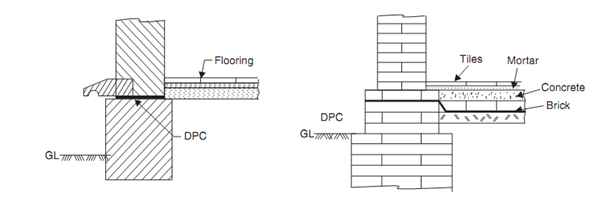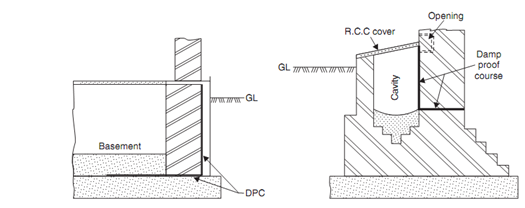METHODS OF DAMP PROOFING
Different methods of damp proofing are following:
I. Providing D.P.C. course
II. Surface treatment
III. Providing cavity walls
IV. Integral treatment
V. Pressure grouting.
VI. Guniting
1. Providing damp proof course: between the source of dampness and building component it consists of providing a damp proof course. DPC can be with any water repellent material such as, mastic asphalt, bitumen, and cement concrete, metal or plastic sheets. DPC ought to cover full width of wall. On levelled surface of mortar it must be laid. Joints must be minimum and should not be at the critical points .The junction should be filled with about 75 mm fillet of cement concrete when horizontal DPC on roof is continued on vertical face of parapet wall. Given figure (a) shows details of providing water proof course at plinth level. Whereas Figure (b) shows the details of water proofing course for wall and floor. Figure (c) shows details of water proofing course for basement.

(a) DPC at plinth level (b) DPC at floor level

(a) DPC for basement (b) Providing cavity wall
2. Providing cavity wall: to protect foundation masonry and the wall Cavity wall can be constructed as shown in above figure (b).From outer to inner wall Cavity prevents moisture travelling.
3. Surface treatment: This method is useful If moisture is superficial only and not under pressure. On the surface it consists of application of layer of water repellant compounds. Some of the water proofing agents used for this treatment are silicates of sodium or, zinc and magnesium, potassium and sulphates of aluminium.
4. Integral treatment: It consists commercially in mixing available compounds in water before concrete is wet mixed. These compounds are made from talc, chalk, flutter earth or chemical compounds such as aluminium sulphate, calcium chloride, calcium chloride etc. Some compounds contain compounds such as soap, fatty acids, petroleum oils etc.
5. Guniting: In this method on the surface to be made water proof a mixture of cement and water is forced by cement gun. Later with pressure using compressed air, 1: 3 or 1: 4 cement mortars is applied to the surface. Hence an impervious layer of mortar is provided.
6. Pressure grouting: This is the method which used to seal cracks in the concrete surfaces. Cement grout is forced under pressure in this method.